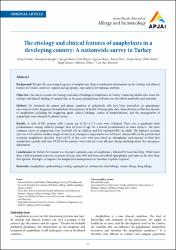The etiology and clinical features of anaphylaxis in a developing country: A nationwide survey in Turkey

Göster/
Tarih
2017Yazar
Civelek, ErsoyErkoçoğlu, Mustafa
Akan, Ayşegül
Özcan, Celal
Kaya, Ayşenur
Vezir, Emine
Kocabaş, Can Naci
Üst veri
Tüm öğe kaydını gösterÖzet
Background: Despite the increasing frequency of anaphylaxis, there is inadequate information on the etiology and clinical features in various countries, regions and age groups, especially in developing countries. Objective: Our aim is to assess the etiology and clinical findings of anaphylaxis in Turkey. Gathering reliable data about the etiology and clinical findings of anaphylaxis in the general population will decrease the related morbidity and mortality. Method: We obtained the names and phone numbers of individuals who had been prescribed an epinephrine auto-injector with a diagnosis of anaphylaxis from ministry of health. Demographic data, clinical history of the first episode of anaphylaxis including the triggering agent, clinical findings, course of hospitalization, and the management of anaphylaxis were obtained by phone survey. Results: A total of 843 patients with a mean age of 21.4 +/- 17.3 years were evaluated. There was a significant male predominance among children younger than 10 years of age but a female predominance in older subjects. The most common causes of anaphylaxis were foods(40.1%) in children and bee venom(60.8%) in adults. The biphasic reaction rate was 4.3% and the median length of stay at an emergency department was 4.0 hours. Almost 60% of the patients had recurrent anaphylaxis episodes. Only 10.7% of the cases were prescribed an epinephrine auto-injector at their first anaphylaxis episode and only 59.2% of the patients were referred to an allergist during discharge from the emergency department. Conclusions: In Turkey, bee venom was the most common cause of anaphylaxis, followed by food and drug. While more than a half of patients reported recurrent attacks; only 10% had been prescribed epinephrine auto-injector kit after their first episode. Strategies to improve the anaphyalxis management are therefore urgently required.

















